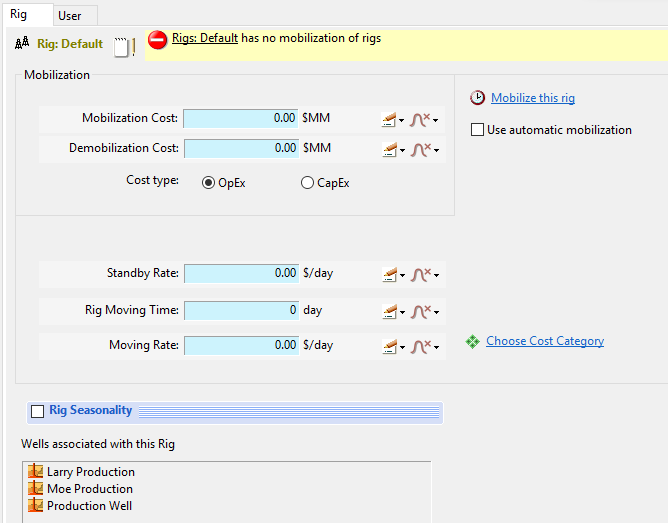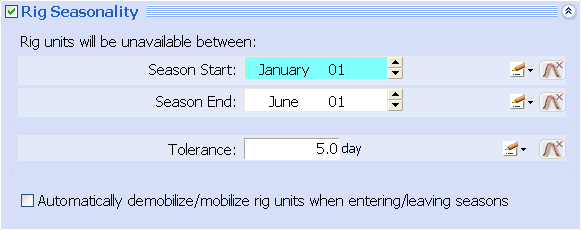Rig Node
Rig nodes are available only in Extended Rig Mode. They allow you to characterize each rig separately.

Click image to expand or minimize.
- Mobilization Cost: The cost of mobilizing, that is, bringing a rig unit of this kind to the project location and getting it ready to work. This expense is incurred every time a Rig Mobilization job is performed.
- Demobilization Cost: The cost of demobilizing, that is, sending a rig unit back when it is no longer needed. This expense is incurred every time a Rig Demobilization job is performed.
- Cost type: Choose whether Mobilization Cost and Demobilization Cost will be regarded as capital or operating expenses when generating results. See Costs.
- Standby Rate: The cost of keeping a mobilized rig unit unused, i.e., not performing a job at the moment.
- Rig Moving Time: Time it takes to move a rig unit from one well to another to begin a new task. Note that this is ignored if both tasks belongs to the same well bore.
- Moving Rate: Cost of moving a rig unit to the next well bore as a function of moving time.
- Use automatic mobilization: Check this option to mobilize new units of this rig only when they are required by drilling/completion/intervention jobs, instead of using a mobilization job with a specific date. Enter a Max Rig Unit to cap the number of available units.
 Choose Cost Category: Use this link to choose a category for these costs; see further in Cost Categories.
Choose Cost Category: Use this link to choose a category for these costs; see further in Cost Categories.
Wells associated with this Rig: This list is not editable; it contains every well that has been assigned this rig for drilling, completion or intervention jobs in its Well Drilling Info tab, Well Completion Info tab and Maintenance Program tab.
Rig Seasonality
A season is a period of time of yearly recurrence, shorter than a year, during which units of a particular rig are not available for performing jobs. It is defined by a start date and an end date, plus an optional time of tolerance.
How Seasonality Works
During the simulation, a rig in PetroVR receives requests to perform jobs, and performs them or rejects them depending on its availability. During the unavailability season, rigs cease to accept requests even if they are still mobilized; not until the season ends will they be able to receive and perform new jobs.
Now, rigs for which an unavailability season has been defined must check, before accepting a job, not only if they are currently available, but also if they will be so for as long as the job lasts. This means that if the next season were to start before the job ends, the rig should not accept the job; in other words, it checks that the job's duration does not extend beyond the availability period.
However, a tolerance time has been introduced to prevent a rig from refusing a job just because it would take a few days of the unavailability season. Without this tolerance a rig intended - for example - to start a 40-days-long Well Drilling job might refuse the job just because it is only 39 days to the season.
The inclusion of a tolerance period means that the start of the unavailability season may find that a rig is currently performing a job. In such cases, the job is not interrupted or aborted, but the rig enters the season immediately after the job is finished.
When the option to Complete Wells Automatically of a drilling job is checked, the job includes the completion, i.e., the rig will either complete both the drilling and the completion or leave both undone; it will not complete only the drilling and leave the completion for the next availability season.
Seasonality and Rig Units
It is important to keep in mind that PetroVR distinguishes between rig and rig unit, which in the context of seasonality implies that when the unavailability season starts, all available units of that rig will become unavailable, and the same number of units will become available when the season ends.
In PetroVR the identity of each rig unit is considered irrelevant for mobilization and demobilization jobs, and so any available unit is picked for demobilization whenever required, and a brand new unit is mobilized each time it is required rather than picking an old (demobilized) one. But in the case of seasonality PetroVR preserves the identity of each rig unit so that the same unit and not a new one will be available after the season. This keeps the Rig usage timeline in the In Last Simulation tab neat and easy to understand. Note that seasonal demobilization of units is also reflected in that tab.

- Season Start: The first day units of this rig become unavailable.
- Season End: The last day units are unavailable.
- Tolerance: The time, typically a number of days, the rig will take into account for accepting a job if the completion of that job implies working beyond the start of the unavailability season.
The option to Automatically demobilize/mobilize rig units when entering/leaving seasons allows you to avoid keeping rigs mobilized and therefore incurring Standby Rate costs over long periods of inactivity. If checked, rigs will be demobilized and mobilized every year - which means that they will incur demobilization/mobilization costs every time.
